 Would you like to get more out of your Facebook advertising?
Would you like to get more out of your Facebook advertising?
Did you know you can now target Facebook ads based on people’s purchase history, job roles and other external insights from major data providers?
Facebook continues to roll out advertising tools that allow marketers to target their ideal customer in ways not seen before.
What Are Partner Categories?
Within the past year, Facebook has launched Custom Audiences, Conversion Tracking, Sponsored Results, Lookalike Audiences and a whole lot more.
Partner Categories is the latest tool added to your Facebook toolbox. Here’s what you need to know and how to use Facebook’s Partner Categories to reach the audience you want with your Facebook advertising.
Facebook partnered with Acxiom, Datalogix and Epsilon to make Partner Categories a reality. These partners provide data on Facebook users’ online and offline activities away from Facebook to create more refined targeting opportunities.
Up until recently, you could target ads to Facebook users based only on the information they provide in their profiles (age, gender, school, location, employer) and both precise and broad interests.
One of the previously added features—Custom Audiences—changed that, adding the ability to combine your offline customer list (email addresses, phone numbers and Facebook UID numbers) with your Facebook advertising efforts.
And now Partner Categories enters the fray to provide access to even more data for Facebook marketers.
Acxiom, Datalogix and Epsilon provide more than 500 categories that you can target associated with things like purchase history, job role and lifestyle.
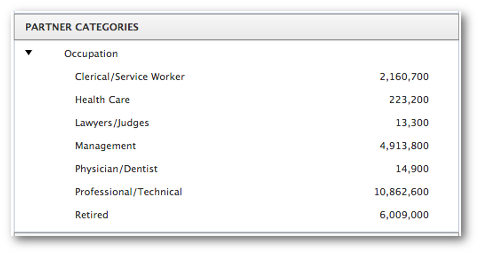
Instead of giving you a list of all 500-plus categories, here are 10 examples that provide a glimpse into the power of Partner Categories:
- Household size of 6 (8,842,800 users)
- Upscale department store credit card user (34,618,400 users)
- Home office supply purchases (2,638,300 users)
- Aftermarket vehicle purchase over 48 months ago (11,952,800 users)
- Baby food & products buyers (10,497,100 users)
- Casino vacations (4,242,000 users)
- Dog owner (12,643,500 users)
- Fitness buyers—runners (5,950,600 users)
- Teacher/educator (223,000 users)
- Donate to veteran causes (7,016,400)
As you can see, these partners are providing Facebook with a ton of data. Individual categories can include up to several million users.
And Facebook will continue adding to this list.
Partner Categories and Privacy
I know what you’re thinking: AHHHH! Advertisers know how much money I make? What I’ve bought? PRIVACY ALERT!
Get World-Class Marketing Training — All Year Long!
Are you facing doubt, uncertainty, or overwhelm? The Social Media Marketing Society can help.
Each month, you’ll receive training from trusted marketing experts, covering everything from AI to organic social marketing. When you join, you’ll also get immediate access to:
- A library of 100+ marketing trainings
- A community of like-minded marketers
- Monthly online community meetups
- Relevant news and trends updates
Rest assured, advertisers know nothing about you as a user. As Facebook marketers, you simply tell Facebook to target users in a specific group, and they do it. It’s the same as when we target women who are age 35-44, live in San Francisco and work at Facebook.
There are no lists of users. There’s just a category name and the number of people who are in it. Facebook does the rest.
When ads are displayed that utilize Partner Categories, users will be able to get more information about what company shared their information and how. Read this post from Facebook about advertising and third-party partners for more info.
Why Are Partner Categories Important?
It’s all about relevancy and efficiency.
Stop wasting your money advertising to people who don’t care about your product, service or niche. Focus on those most likely to relate to what you have to say.
This also opens up opportunities for selling on Facebook. Imagine you are in the travel industry and offer packages for seniors. You could target users in Datalogix categories like this:
- Take cruises (13,020,0400 users)
- Affluent baby boomers (17,098,700 users)
- Leisure travelers (22,800,900 users)
You could then target those who qualify in all three groups, and your list is cut down to about 4 million users.

Discover Proven Marketing Strategies and Tips
Want to go even deeper with your marketing? Check out the Social Media Marketing Podcast! Publishing weekly since 2012, the Social Media Marketing Podcast helps you navigate the constantly changing marketing jungle, with expert interviews from marketing pros.
But don’t let the name fool you. This show is about a lot more than just social media marketing. With over 600 episodes and millions of downloads each year, this show has been a trusted source for marketers for well over a decade.
Or maybe you sell new Ford trucks valued over $30,000. You could target users in Datalogix categories as follows:
- Pickup truck owner (17,904,500 users)
- Make is Ford truck (10,647,400 users)
- Vehicle age is 6-10 years old (31,187,100 users)
- Price is $30K-40K (2,249,400 users)
If you cross these categories, you end up with about 37 million users.
But your dealership is in Milwaukee, WI. If you target only men within 25 miles of Milwaukee who fit within these categories, the new audience is 71,500.
That’s right. Just over 70,000 Ford truck owners in the Milwaukee area (that’s a lot of Ford trucks in the Milwaukee area!) who may be on the lookout for a new Ford truck. You can target them.
Powerful, right?
How to Use Partner Categories
First of all, this is only available to advertisers within the U.S. for now. If you’re outside the U.S., stay tuned.
Second, Facebook says they are rolling this out to both Power Editor and the self-serve ad tool. I only have this within Power Editor. If you want access to all of the good stuff, you should be using Power Editor anyway.
While creating an ad, go to the Audience tab. Under Precise Interests is a Categories box. This holds both Facebook Broad Categories and Partner Categories.
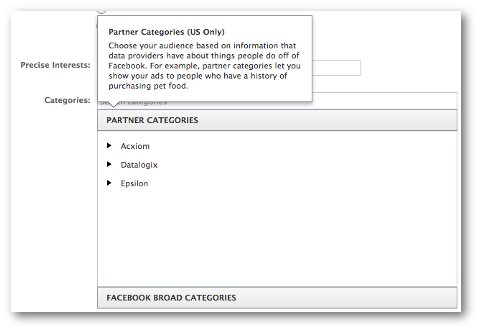
As mentioned earlier, you can grab categories from Acxiom, Datalogix and Epsilon. Just know that you can only pull categories from one of those partners for an individual ad.
Expand Acxiom, Datalogix or Epsilon to view the categories contained within them. Then select any of the categories that you want (again, only select categories within a single partner group).
Here’s what it would look like based on the travel company example from earlier.
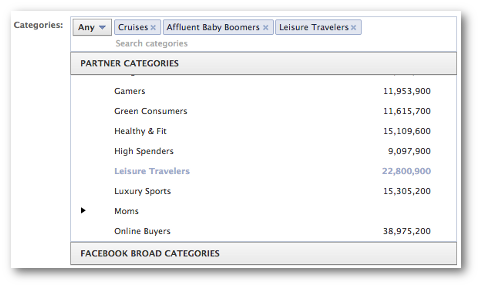
Hover over a selected category and a tooltip description will come up. Here’s the description for “Affluent Baby Boomers”.
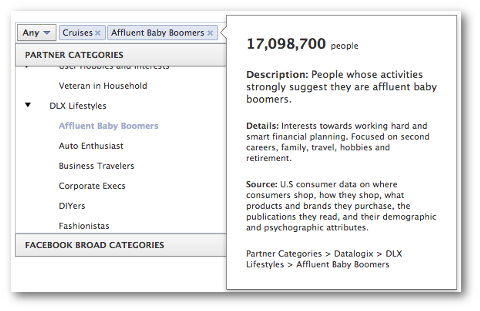
You can choose to target people who like ANY or ALL of these categories by clicking on the drop-down to the left…
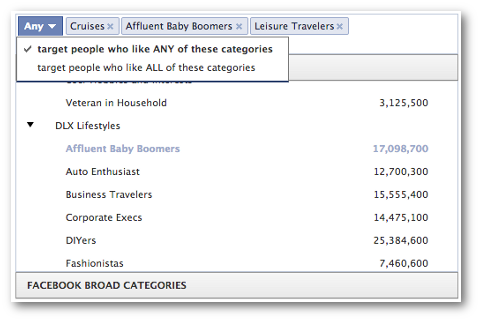
If you don’t feel like digging through all 500-plus categories (it’s admittedly a bit clunky to expand and collapse repeatedly to find what you want), you can also start typing a keyword in the category search.
I started typing “Marketing” and the category “Sales/Marketing” came up.

Partner Category targeting can then be used in addition to your other targeting like age, gender, location and interests.
Partner Category Reminders
To recap, here are the main things to remember if you’re going to start using Partner Categories today:
- Target users based on buying activity away from Facebook.
- Use Power Editor.
- Only available in the U.S.
- Target multiple categories, but only one partner at a time.
- Use Partner Categories in addition to other targeting.
- Nothing changes regarding privacy.
Now, it’s your turn to give it a try!
Is Partner Category Targeting Effective?
This form of targeting on Facebook is too new to say just how effective it is yet, and it will largely depend on the quality of the data. But there’s certainly potential here.
What do you think? Have you used Partner Categories? What results are you seeing? Let us know in the comments section below!
Attention Agency Owners, Brand Marketers, and Consultants

Introducing the Marketing Agency Show–our newest podcast designed to explore the struggles of agency marketers.
Join show host and agency owner, Brooke Sellas, as she interviews agency marketers and digs deep into their biggest challenges. Explore topics like navigating rough economic times, leveraging AI, service diversification, client acquisition, and much more.
Just pull up your favorite podcast app, search for Marketing Agency Show and start listening. Or click the button below for more information.

